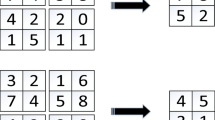Abstract
Salient Object Detection (SOD) based on Convolutional Neural Networks (CNNs) has been widely studied recently. How to maintain a complete and clear object boundary structure is still a key issue. Existing works with the utilization of edge information have already improved this issue to some extent. However, these methods extract boundary features indiscriminately, which may weaken useful edge information and mislead edge construction. To address this problem, we present an Edge Recalibration Network (ERN) model for image-based SOD to perform edge-guided features effectively. In a specific, a progressive Fully Convolutional neural Networks (FCNs) for SOD is adopted to incorporate multi-scale and multi-level features. Besides, to locate the edge position and preserve the boundary features accurately, we propose an edge enhancement module with pixel-wise semantic-edge integration and channel-wise feature recalibration. Based on pixelwise semantic-edge integration, the semantic features and boundary features are integrated into the holistic feature maps. Based on channel-wise feature recalibration, the boundary features selectively recalibrate salient semantic features on channel dimension, aiming to enhance useful features and suppress useless features, for the similarity of boundary features and salient semantic features. Experimental results on five popular benchmark datasets show that the proposed model ERN outperforms other state-of-the-art methods under different evaluation metrics.
Access this chapter
Tax calculation will be finalised at checkout
Purchases are for personal use only
Similar content being viewed by others
References
Lee, G., Tai, Y.W., Kim, J.: Deep saliency with encoded low-level distance map and high-level features. In: Proceedings of Computer Vision and Pattern Recognition, pp. 660–668. IEEE, Las Vegas (2016)
Wang, W., Zhao, S., Shen, J.: Salient object detection with pyramid attention and salient edges. In: Proceedings of Computer Vision and Pattern Recognition. pp. 1448–1457. IEEE, California (2019)
Karen, S., Andrew, Z.: Very deep convolutional networks for large-scale image recognition. In: Proceedings of International Conference on Learning Representations, San Diego (2015)
He, K.M., Zhang, X., Ren, S.Q.: Deep residual learning for image recognition. In: Proceedings of Computer Vision and Pattern Recognition, pp. 770–778. IEEE, Las Vegas (2016)
Ronneberger, O., Fischer, P., Brox, T.: U-Net: convolutional networks for biomedical image segmentation. In: Navab, N., Hornegger, J., Wells, W.M., Frangi, A.F. (eds.) MICCAI 2015. LNCS, vol. 9351, pp. 234–241. Springer, Cham (2015). https://doi.org/10.1007/978-3-319-24574-4_28
Luo, Z., Mishra, A., Achkar, A.: Non-local deep features for salient object detection. In: Proceedings of Computer Vision and Pattern Recognition, pp. 6609–6617. IEEE, Hawaii (2017)
Zhao, T., Wu, X.: Pyramid feature attention network for saliency detection. In: Proceedings of the IEEE Conference on Computer Vision and Pattern Recognition, pp. 3085–3094. IEEE, California (2019)
Hou, Q., Cheng, M., Hu, X., Borji, A.: Deeply supervised salient object detection with short connections. IEEE Trans. Pattern Anal. Mach. Intell. (2019)
Wang, T., Zhang, L., Wang, S., Lu, H.: Detect globally, refine locally: a novel approach to saliency detection. In: Proceedings of Computer Vision and Pattern Recognition, pp. 3127–3135. IEEE, Salt Lake (2018)
Zhang, P., Wang, D., Lu, H., Wang, H.: Amulet: aggregating multi-level convolutional features for salient object detection. In: Proceedings of International Conference on Computer Vision, pp. 202–211. IEEE, Venice (2017)
Wang, T., Borji, A., Zhang, L.: A stagewise refinement model for detecting salient objects in images. In: Proceedings of International Conference on Computer Vision, pp. 4019–4028. IEEE, Venice (2017)
Feng, M., Lu, H., Ding, E.: Attentive feedback network for boundary-aware salient object detection. In: Proceedings of Computer Vision and Pattern Recognition, pp. 1623–1632. IEEE, California (2019)
Zhang, X., Wang, T., Qi, J., Lu, H., Wang, G.: Progressive attention guided recurrent network for salient object detection. In: Proceedings of Conference on Computer Vision and Pattern Recognition, pp. 714–722. IEEE, Salt Lake (2018)
Chen, S., Tan, X., Wang, B., Hu, X.: Reverse attention for salient object detection. In: Ferrari, V., Hebert, M., Sminchisescu, C., Weiss, Y. (eds.) ECCV 2018. LNCS, vol. 11213, pp. 236–252. Springer, Cham (2018). https://doi.org/10.1007/978-3-030-01240-3_15
Zhang, P., Wang, D., Lu, H., Wang H., Yin, B.: Learning uncertain convolutional features for accurate saliency detection. In: Proceedings of International Conference on Computer Vision, pp. 212–221. IEEE, Venice (2017)
Zeng, Y., Zhang, P.: Towards high-resolution salient object detection. In: Proceedings of International Conference on Computer Vision, pp. 7234–7243. IEEE, Seoul (2019)
Zhao, J., Liu, J., Fan, D., Cao, Y., Yang, J., Cheng, M.: EGNet: edge guidance network for salient object detection. In: Proceedings of Conference on Computer Vision, pp. 8779–8788. IEEE, Seoul (2019)
Li, X., Yang, F., Cheng, H., Liu, W., Shen, D.: Contour knowledge transfer for salient object detection. In: Ferrari, V., Hebert, M., Sminchisescu, C., Weiss, Y. (eds.) ECCV 2018. LNCS, vol. 11219, pp. 370–385. Springer, Cham (2018). https://doi.org/10.1007/978-3-030-01267-0_22
Zhang, L., Dai, J., Lu, H., He, Y., Wang, G.: A bi-directional message passing model for salient object detection. In: Proceedings of Computer Vision and Pattern Recognition. pp. 1741–1750. IEEE, Salt Lake (2018)
Li, Z., Peng, C., Yu, G., Sun, J.: Detnet: a backbone network for object detection. In: Proceedings of European Conference on Computer Vision. Springer, Munich (2018)
Acknowledgements
This work was supported in part by National Natural Science Foundation of China under grant 61771145 and 61371148.
Author information
Authors and Affiliations
Corresponding author
Editor information
Editors and Affiliations
Rights and permissions
Copyright information
© 2020 Springer Nature Switzerland AG
About this paper
Cite this paper
Tan, Z., Hua, Y., Gu, X. (2020). Salient Object Detection with Edge Recalibration. In: Farkaš, I., Masulli, P., Wermter, S. (eds) Artificial Neural Networks and Machine Learning – ICANN 2020. ICANN 2020. Lecture Notes in Computer Science(), vol 12396. Springer, Cham. https://doi.org/10.1007/978-3-030-61609-0_57
Download citation
DOI: https://doi.org/10.1007/978-3-030-61609-0_57
Published:
Publisher Name: Springer, Cham
Print ISBN: 978-3-030-61608-3
Online ISBN: 978-3-030-61609-0
eBook Packages: Computer ScienceComputer Science (R0)




